Polynomial Expressions for the Thermal Efficiency of the Parabolic Trough Solar Collector
Abstract
1. Introduction
2. Material and Methods
2.1. The Examined Collector
2.2. Basic Mathematical Formulation
2.3. Validation of the Developed Model in EES
2.4. Followed Methodology for the Approximation Methods
3. Results
3.1. Initial Analysis
3.2. Total Analysis
4. Conclusions
- -
- The use of the third-order term “ΔΤ3/Gb” is the most important term which can lead to relatively accurate results, especially in cases with a low number of terms.
- -
- The use of the temperature difference term “ΔΤ” is important and it can lead to high improvement compared to the respective formulas without it.
- -
- The most promising formula by taking into account the use of a low number of parameters and to achieve high accuracy is the following:, (R2 = 99.92% – MAPE = 0.13%) or in a general form:
- -
- It is found and discussed that there is a need for using the proper terms and not using many terms in order to achieve high accuracy.
- -
- In the future, there is a need for extending the present work by taking into consideration the wind speed, the solar angle and the flow rate. Moreover, there is a need for studying extra PTC modules with different characteristics than the present one, for example with a non-selective absorber, with a non-evacuated receiver and with different working fluid.
Author Contributions
Funding
Conflicts of Interest
Nomenclature
| A | Area, m2 |
| αi | Approximation coefficient (i = 0, 1, 2, 3, 4) |
| b | Approximation coefficient, K−1 |
| ci | Approximation coefficient (i = 0, 1, 2, 3, 4) |
| C | Concentration ratio |
| cp | Specific heat capacity under constant pressure, J kg−1 K−1 |
| D | Diameter, m |
| EL | Longwave irradiance, W m−2 |
| F | Focal distance, m |
| Gb | Solar direct beam irradiation, W m−2 |
| h | Heat transfer coefficient of the flow, W m−2 K−1 |
| hout | Convection coefficient between cover and ambient, W m−2 K−1 |
| i | Counter |
| k | Thermal conductivity, W m−1 K−1 |
| L | Tube length, m |
| m | Power of the approximation term |
| moil | Thermal oil mass flow rate, kg s−1 |
| n | Number of the examined scenarios |
| Nu | Nusselt number |
| Pr | Prandtl number |
| Q | Heat rate, W |
| Re | Reynolds number |
| R2 | Coefficient of determination |
| T | Temperature, °C |
| Tsky | Sky temperature, K |
| V | Volumetric flow rate, L min−1 |
| Vw | Wind speed, m s−1 |
| Wa | Width, m |
| Greek symbols | |
| α | Absorbance |
| γ | Intercept factor |
| ΔΤ | Temperature difference [= Tin − Tam], °C |
| ε | Emittance |
| ηcol | Collector thermal efficiency |
| ηopt | Optical efficiency |
| θ | Solar incident angle, ° |
| μ | Dynamic Viscosity, Pa s |
| ρ | Equivalent reflectance |
| σ | Stefan-Boltzmann constant [= 5.67 ∙ 10−8 W m−2 K−4] |
| τ | Transmittance |
| Subscripts and superscripts | |
| a | aperture |
| am | ambient |
| aprx | approximation |
| b | beam |
| c | cover |
| ci | cover inner |
| co | outer cover |
| d | diffuse |
| fm | mean fluid |
| in | inlet |
| m | power of the approximation term |
| max | maximum |
| out | outlet |
| r | receiver |
| ri | inner receiver |
| ro | receiver outer |
| s | solar |
| u | useful |
Abbreviations
| EES | Engineering equation solver |
| MAPE | Mean absolute percentage error |
| PTC | Parabolic trough collector |
Appendix A—Dataset for the Present Work
| Tin (°C) | ΔΤ (°C) | Gb (W/m2) | ηcol | |||
|---|---|---|---|---|---|---|
| EES | Equation (A1) | Equation (A2) | Equation (A3) | |||
| 25 | 0 | 1000 | 0.73056 | 0.72547 | 0.73116 | 0.73187 |
| 75 | 50 | 1000 | 0.72885 | 0.72530 | 0.72831 | 0.72876 |
| 125 | 100 | 1000 | 0.72550 | 0.72406 | 0.72452 | 0.72461 |
| 175 | 150 | 1000 | 0.72007 | 0.72070 | 0.71887 | 0.71883 |
| 225 | 200 | 1000 | 0.71183 | 0.71415 | 0.71044 | 0.71060 |
| 275 | 250 | 1000 | 0.69965 | 0.70336 | 0.69828 | 0.69886 |
| 325 | 300 | 1000 | 0.68187 | 0.68726 | 0.68147 | 0.68237 |
| 375 | 350 | 1000 | 0.65670 | 0.66479 | 0.65909 | 0.65966 |
| 25 | 0 | 950 | 0.73067 | 0.72547 | 0.73116 | 0.73187 |
| 75 | 50 | 950 | 0.72886 | 0.72529 | 0.72830 | 0.72873 |
| 125 | 100 | 950 | 0.72540 | 0.72398 | 0.72446 | 0.72451 |
| 175 | 150 | 950 | 0.71979 | 0.72044 | 0.71865 | 0.71856 |
| 225 | 200 | 950 | 0.71125 | 0.71355 | 0.70992 | 0.71003 |
| 275 | 250 | 950 | 0.69862 | 0.70219 | 0.69726 | 0.69781 |
| 325 | 300 | 950 | 0.68021 | 0.68524 | 0.67971 | 0.68060 |
| 375 | 350 | 950 | 0.65412 | 0.66159 | 0.65629 | 0.65682 |
| 25 | 0 | 900 | 0.73076 | 0.72547 | 0.73116 | 0.73187 |
| 75 | 50 | 900 | 0.72887 | 0.72528 | 0.72829 | 0.72870 |
| 125 | 100 | 900 | 0.72528 | 0.72390 | 0.72438 | 0.72439 |
| 175 | 150 | 900 | 0.71946 | 0.72017 | 0.71841 | 0.71826 |
| 225 | 200 | 900 | 0.71060 | 0.71289 | 0.70934 | 0.70940 |
| 275 | 250 | 900 | 0.69748 | 0.70090 | 0.69613 | 0.69665 |
| 325 | 300 | 900 | 0.67834 | 0.68301 | 0.67775 | 0.67862 |
| 375 | 350 | 900 | 0.65124 | 0.65804 | 0.65318 | 0.65367 |
| 25 | 0 | 850 | 0.73086 | 0.72547 | 0.73116 | 0.73187 |
| 75 | 50 | 850 | 0.72886 | 0.72526 | 0.72828 | 0.72867 |
| 125 | 100 | 850 | 0.72513 | 0.72381 | 0.72430 | 0.72426 |
| 175 | 150 | 850 | 0.71908 | 0.71985 | 0.71814 | 0.71792 |
| 225 | 200 | 850 | 0.70986 | 0.71215 | 0.70869 | 0.70869 |
| 275 | 250 | 850 | 0.69618 | 0.69945 | 0.69486 | 0.69535 |
| 325 | 300 | 850 | 0.67623 | 0.68051 | 0.67556 | 0.67641 |
| 375 | 350 | 850 | 0.64799 | 0.65408 | 0.64970 | 0.65015 |
| 25 | 0 | 800 | 0.73095 | 0.72547 | 0.73116 | 0.73187 |
| 75 | 50 | 800 | 0.72884 | 0.72525 | 0.72827 | 0.72863 |
| 125 | 100 | 800 | 0.72496 | 0.72370 | 0.72421 | 0.72411 |
| 175 | 150 | 800 | 0.71865 | 0.71950 | 0.71783 | 0.71754 |
| 225 | 200 | 800 | 0.70901 | 0.71132 | 0.70796 | 0.70790 |
| 275 | 250 | 800 | 0.69470 | 0.69783 | 0.69344 | 0.69388 |
| 325 | 300 | 800 | 0.67384 | 0.67770 | 0.67310 | 0.67393 |
| 375 | 350 | 800 | 0.64432 | 0.64961 | 0.64579 | 0.64619 |
| 25 | 0 | 750 | 0.73104 | 0.72547 | 0.73116 | 0.73187 |
| 75 | 50 | 750 | 0.72881 | 0.72524 | 0.72825 | 0.72859 |
| 125 | 100 | 750 | 0.72474 | 0.72359 | 0.72411 | 0.72394 |
| 175 | 150 | 750 | 0.71814 | 0.71910 | 0.71748 | 0.71710 |
| 225 | 200 | 750 | 0.70803 | 0.71037 | 0.70713 | 0.70700 |
| 275 | 250 | 750 | 0.69301 | 0.69598 | 0.69182 | 0.69222 |
| 325 | 300 | 750 | 0.67111 | 0.67452 | 0.67031 | 0.67111 |
| 375 | 350 | 750 | 0.64012 | 0.64456 | 0.64136 | 0.64170 |
| 25 | 0 | 700 | 0.73112 | 0.72547 | 0.73116 | 0.73187 |
| 75 | 50 | 700 | 0.72876 | 0.72522 | 0.72824 | 0.72854 |
| 125 | 100 | 700 | 0.72449 | 0.72345 | 0.72399 | 0.72375 |
| 175 | 150 | 700 | 0.71755 | 0.71865 | 0.71708 | 0.71661 |
| 225 | 200 | 700 | 0.70690 | 0.70930 | 0.70619 | 0.70597 |
| 275 | 250 | 700 | 0.69106 | 0.69388 | 0.68998 | 0.69033 |
| 325 | 300 | 700 | 0.66797 | 0.67088 | 0.66712 | 0.66790 |
| 375 | 350 | 700 | 0.63530 | 0.63878 | 0.63630 | 0.63656 |
| 25 | 0 | 650 | 0.73120 | 0.72547 | 0.73116 | 0.73187 |
| 75 | 50 | 650 | 0.72870 | 0.72520 | 0.72822 | 0.72849 |
| 125 | 100 | 650 | 0.72418 | 0.72330 | 0.72385 | 0.72352 |
| 175 | 150 | 650 | 0.71685 | 0.71812 | 0.71662 | 0.71604 |
| 225 | 200 | 650 | 0.70558 | 0.70805 | 0.70510 | 0.70478 |
| 275 | 250 | 650 | 0.68880 | 0.69145 | 0.68785 | 0.68814 |
| 325 | 300 | 650 | 0.66433 | 0.66668 | 0.66344 | 0.66418 |
| 375 | 350 | 650 | 0.62971 | 0.63211 | 0.63045 | 0.63064 |
| 25 | 0 | 600 | 0.73127 | 0.72547 | 0.73116 | 0.73187 |
| 75 | 50 | 600 | 0.72860 | 0.72518 | 0.72820 | 0.72843 |
| 125 | 100 | 600 | 0.72381 | 0.72311 | 0.72369 | 0.72326 |
| 175 | 150 | 600 | 0.71602 | 0.71751 | 0.71608 | 0.71538 |
| 225 | 200 | 600 | 0.70402 | 0.70660 | 0.70382 | 0.70340 |
| 275 | 250 | 600 | 0.68613 | 0.68861 | 0.68536 | 0.68559 |
| 325 | 300 | 600 | 0.66005 | 0.66178 | 0.65915 | 0.65985 |
| 375 | 350 | 600 | 0.62316 | 0.62433 | 0.62364 | 0.62373 |
| 25 | 0 | 550 | 0.73135 | 0.72547 | 0.73116 | 0.73187 |
| 75 | 50 | 550 | 0.72848 | 0.72515 | 0.72818 | 0.72835 |
| 125 | 100 | 550 | 0.72336 | 0.72290 | 0.72351 | 0.72296 |
| 175 | 150 | 550 | 0.71502 | 0.71679 | 0.71545 | 0.71459 |
| 225 | 200 | 550 | 0.70217 | 0.70488 | 0.70232 | 0.70176 |
| 275 | 250 | 550 | 0.68296 | 0.68526 | 0.68243 | 0.68257 |
| 325 | 300 | 550 | 0.65496 | 0.65599 | 0.65408 | 0.65473 |
| 375 | 350 | 550 | 0.61538 | 0.61513 | 0.61558 | 0.61557 |
| 25 | 0 | 500 | 0.73141 | 0.72547 | 0.73116 | 0.73187 |
| 75 | 50 | 500 | 0.72831 | 0.72512 | 0.72815 | 0.72826 |
| 125 | 100 | 500 | 0.72280 | 0.72264 | 0.72328 | 0.72259 |
| 175 | 150 | 500 | 0.71381 | 0.71592 | 0.71469 | 0.71365 |
| 225 | 200 | 500 | 0.69992 | 0.70283 | 0.70052 | 0.69980 |
| 275 | 250 | 500 | 0.67914 | 0.68124 | 0.67890 | 0.67895 |
| 325 | 300 | 500 | 0.64884 | 0.64904 | 0.64799 | 0.64859 |
| 375 | 350 | 500 | 0.60600 | 0.60410 | 0.60591 | 0.60577 |
| 25 | 0 | 450 | 0.73148 | 0.72547 | 0.73116 | 0.73187 |
| 75 | 50 | 450 | 0.72810 | 0.72508 | 0.72812 | 0.72815 |
| 125 | 100 | 450 | 0.72210 | 0.72233 | 0.72300 | 0.72214 |
| 175 | 150 | 450 | 0.71231 | 0.71486 | 0.71376 | 0.71250 |
| 225 | 200 | 450 | 0.69715 | 0.70031 | 0.69831 | 0.69740 |
| 275 | 250 | 450 | 0.67444 | 0.67633 | 0.67460 | 0.67452 |
| 325 | 300 | 450 | 0.64132 | 0.64055 | 0.64055 | 0.64108 |
| 375 | 350 | 450 | 0.59451 | 0.59061 | 0.59410 | 0.59380 |
| 25 | 0 | 400 | 0.73153 | 0.72547 | 0.73116 | 0.73187 |
| 75 | 50 | 400 | 0.72780 | 0.72503 | 0.72807 | 0.72801 |
| 125 | 100 | 400 | 0.72121 | 0.72193 | 0.72266 | 0.72158 |
| 175 | 150 | 400 | 0.71042 | 0.71353 | 0.71260 | 0.71106 |
| 225 | 200 | 400 | 0.69366 | 0.69716 | 0.69556 | 0.69440 |
| 275 | 250 | 400 | 0.66853 | 0.67018 | 0.66921 | 0.66899 |
| 325 | 300 | 400 | 0.63188 | 0.62993 | 0.63125 | 0.63170 |
| 375 | 350 | 400 | 0.58009 | 0.57375 | 0.57933 | 0.57883 |
| 25 | 0 | 350 | 0.73158 | 0.72547 | 0.73116 | 0.73187 |
| 75 | 50 | 350 | 0.72741 | 0.72497 | 0.72802 | 0.72784 |
| 125 | 100 | 350 | 0.72005 | 0.72143 | 0.72222 | 0.72086 |
| 175 | 150 | 350 | 0.70796 | 0.71182 | 0.71110 | 0.70921 |
| 225 | 200 | 350 | 0.68915 | 0.69312 | 0.69201 | 0.69054 |
| 275 | 250 | 350 | 0.66091 | 0.66228 | 0.66229 | 0.66188 |
| 325 | 300 | 350 | 0.61971 | 0.61628 | 0.61929 | 0.61963 |
| 375 | 350 | 350 | 0.56150 | 0.55208 | 0.56034 | 0.55959 |
| 25 | 0 | 300 | 0.73161 | 0.72547 | 0.73116 | 0.73187 |
| 75 | 50 | 300 | 0.72686 | 0.72488 | 0.72794 | 0.72760 |
| 125 | 100 | 300 | 0.71847 | 0.72075 | 0.72163 | 0.71990 |
| 175 | 150 | 300 | 0.70466 | 0.70955 | 0.70911 | 0.70674 |
| 225 | 200 | 300 | 0.68311 | 0.68773 | 0.68729 | 0.68540 |
| 275 | 250 | 300 | 0.65071 | 0.65175 | 0.65307 | 0.65240 |
| 325 | 300 | 300 | 0.60343 | 0.59808 | 0.60334 | 0.60355 |
| 375 | 350 | 300 | 0.53665 | 0.52318 | 0.53502 | 0.53393 |
References
- Bellos, E.; Tzivanidis, C. Alternative designs of parabolic trough solar collectors. Prog. Energy Combust. Sci. 2019, 71, 81–117. [Google Scholar] [CrossRef]
- Shahverdi, K.; Loni, R.; Ghobadian, B.; Monem, M.J.; Gohari, S.; Marofi, S.; Najafi, G. Energy harvesting using solar ORC system and Archimedes Screw Turbine (AST) combination with different refrigerant working fluids. Energy Convers. Manag. 2019, 187, 205–220. [Google Scholar] [CrossRef]
- Silva, R.; Berenguel, M.; García, M.P.; Fernández-García, A. Thermo-economic design optimization of parabolic trough solar plants for industrial process heat applications with memetic algorithms. Appl. Energy 2014, 113, 603–614. [Google Scholar] [CrossRef]
- Cabrera, F.; Fernández-García, A.; Silva, R.; García, M.P. Use of parabolic trough solar collectors for solar refrigeration and air-conditioning applications. Renew. Sustain. Energy Rev. 2013, 20, 103–118. [Google Scholar] [CrossRef]
- Tian, Z.; Perers, B.; Furbo, S.; Fan, J. Thermo-economic optimization of a hybrid solar district heating plant with flat plate collectors and parabolic trough collectors in series. Energy Convers. Manag. 2018, 165, 92–101. [Google Scholar] [CrossRef]
- Mosaffa, A.; Ghaffarpour, Z.; Farshi, L.G. Thermoeconomic assessment of a novel integrated CHP system incorporating solar energy based biogas-steam reformer with methanol and hydrogen production. Sol. Energy 2019, 178, 1–16. [Google Scholar] [CrossRef]
- Kasaeian, A.; Bellos, E.; Shamaeizadeh, A.; Tzivanidis, C. Solar-driven polygeneration systems: Recent progress and outlook. Appl. Energy 2020, 264, 114764. [Google Scholar] [CrossRef]
- Kumar, A.; Sharma, M.; Thakur, P.; Thakur, V.; Rahatekar, S.; Kumar, R. A review on exergy analysis of solar parabolic collectors. Sol. Energy 2020, 197, 411–432. [Google Scholar] [CrossRef]
- Bellos, E.; Tzivanidis, C.; Tsimpoukis, D. Thermal, hydraulic and exergetic evaluation of a parabolic trough collector operating with thermal oil and molten salt based nanofluids. Energy Convers. Manag. 2018, 156, 388–402. [Google Scholar] [CrossRef]
- Xu, H.; Li, Y.; Sun, J.; Li, L. Transient model and characteristics of parabolic-trough solar collectors: Molten salt vs. synthetic oil. Sol. Energy 2019, 182, 182–193. [Google Scholar] [CrossRef]
- Bellos, E.; Tzivanidis, C.; Antonopoulos, K.A.; Daniil, I. The use of gas working fluids in parabolic trough collectors—An energetic and exergetic analysis. Appl. Therm. Eng. 2016, 109A, 1–14. [Google Scholar] [CrossRef]
- Kalogirou, S. Parabolic trough collector system for low temperature steam generation: Design and performance characteristics. Appl. Energy 1996, 55, 1–19. [Google Scholar] [CrossRef]
- Coccia, G.; Di Nicola, G.; Sotte, M. Design, manufacture, and test of a prototype for a parabolic trough collector for industrial process heat. Renew. Energy 2015, 74, 727–736. [Google Scholar] [CrossRef]
- Duffie, J.A.; Beckman, W.A. Solar Engineering of Thermal Processes, 2nd ed.; Wiley: New York, NY, USA, 1991. [Google Scholar]
- ISO. Standard 9806-1: Test Methods for Solar Collectors. Part 1: Thermal Performance of Liquid Heating Collectors Including Pressure Drop; ISO: Geneva, Switzerland, 1994. [Google Scholar]
- Bellos, E.; Tzivanidis, C.; Belessiotis, V. Daily performance of parabolic trough solar collectors. Sol. Energy 2017, 158, 663–678. [Google Scholar] [CrossRef]
- Kalogirou, S.A.; Panayiotou, G. Evaluation of a Parabolic Trough Collector Performance. In Proceedings of the World Renewable Energy Forum, WREF 2012, Including World Renewable Energy Congress XII and Colorado Renewable Energy Society (CRES) Annual Conference, Denver, CO, USA, 13–17 May 2012; Volume 3, pp. 2085–2091. [Google Scholar]
- Dudley, V.; Kolb, G.; Sloan, M.; Kearney, D. SEGS LS2 Solar Collector-Test Results, Report of Sandia National Laboratories, SAN94-1884; Sandia National Laboratories: Albuquerque, NM, USA, 1994. [Google Scholar]
- Kutscher, C.; Burkholder, F.; Stynes, J.K. Generation of a Parabolic Trough Collector Efficiency Curve From Separate Measurements of Outdoor Optical Efficiency and Indoor Receiver Heat Loss. J. Sol. Energy Eng. 2011, 134, 011012. [Google Scholar] [CrossRef]
- Nemś, M.; Kasperski, J. Determining non-linear characteristics of a concentrating solar collector according to the experiment design. J. Phys. Conf. Ser. 2016, 745, 032107. [Google Scholar] [CrossRef]
- Sallaberry, F.; Bello, A.; Burgaleta, J.I.; Fernández-García, A.; Fernández-Reche, J.; Gomez, J.A.; Herrero, S.; Lüpfert, E.; Morillo, R.; Vicente, G.S.; et al. Standards for components in concentrating solar thermal power plants—Status of the Spanish working group. In Proceedings of the SOLARPACES 2015: International Conference on Concentrating Solar Power and Chemical Energy Systems, Cape Town, South Africa, 13–16 October 2015; AIP Publishing: University Park City, MA, USA, 2016; Volume 1734, p. 110003. [Google Scholar]
- IEC. IEC 62817, Solar Trackers for Photovoltaic Systems—Design Qualification; IEC: Geneva, Switzerland, 2014. [Google Scholar]
- Odeh, S.D.; Morrison, G.L.; Behnia, M. Thermal analysis of parabolic trough solar collectors for electric power generation. In Proceedings of the ANZSES Annual Conference, Darwin, Australia, 22–25 October 1996; pp. 460–467. [Google Scholar]
- Sallaberry, F.; Valenzuela, L.; Palacin, L.G.; Leon, J.; Fischer, S.; Bohren, A. Harmonization of standards for parabolic trough collector testing in solar thermal power plants. In Proceedings of the SOLARPACES 2016: International Conference on Concentrating Solar Power and Chemical Energy Systems, Abu Dhabi, The United Arab Emirates, 11–14 October 2016; AIP Publishing: University Park, MA, USA, 2017; Volume 1850, p. 20014. [Google Scholar]
- Sallaberry, F.; Valenzuela, L.; Palacin, L.G. On-site parabolic-trough collector testing in solar thermal power plants: Experimental validation of a new approach developed for the IEC 62862-3-2 standard. Sol. Energy 2017, 155, 398–409. [Google Scholar] [CrossRef]
- ISO. DIS/ISO 9806 Standard Draft Solar Energy—Test Method for Solar Collectors; ISO: Geneva, Switzerland, 2017. [Google Scholar]
- Xu, L.; Wang, Z.; Li, X.; Yuan, G.; Sun, F.; Lei, D.; Li, S. A comparison of three test methods for determining the thermal performance of parabolic trough solar collectors. Sol. Energy 2014, 99, 11–27. [Google Scholar] [CrossRef]
- Bellos, E.; Tzivanidis, C. Analytical Expression of Parabolic Trough Solar Collector Performance. Designs 2018, 2, 9. [Google Scholar] [CrossRef]
- Lüpfert, E.; Herrmann, U.; Price, H.; Zarza, E.; Kistner, R. Towards standard performance analysis for parabolic trough collector fields. In Proceedings of the SolarPaces Conference, Oaxaca, Mexico, 6–9 September 2004. [Google Scholar]
- F-Chart Software, Engineering Equation Solver (EES). 2015. Available online: http://www.fchart.com/ees (accessed on 23 August 2020).
- Forristall, R. Heat Transfer Analysis and Modeling of a Parabolic Trough Solar Receiver Implemented in Engineering Equation Solver; National Renewable Energy Laboratory (NREL): Golden, CO, USA, 2003. [Google Scholar]
- Behar, O.; Khellaf, A.; Mohammedi, K. A novel parabolic trough solar collector model—Validation with experimental data and comparison to Engineering Equation Solver (EES). Energy Convers. Manag. 2015, 106, 268–281. [Google Scholar] [CrossRef]
- Tzivanidis, C.; Bellos, E.; Korres, D.; Antonopoulos, K.; Mitsopoulos, G. Thermal and optical efficiency investigation of a parabolic trough collector. Case Stud. Therm. Eng. 2015, 6, 226–237. [Google Scholar] [CrossRef]
- Swinbank, W.C. Long-wave radiation from clear skies. Q. J. R. Meteorol. Soc. 1963, 89, 339–348. [Google Scholar] [CrossRef]
- Bhowmik, N.; Mullick, S. Calculation of tubular absorber heat loss factor. Sol. Energy 1985, 35, 219–225. [Google Scholar] [CrossRef]
- Bellos, E.; Tzivanidis, C.; Tsimpoukis, D. Enhancing the performance of parabolic trough collectors using nanofluids and turbulators. Renew. Sustain. Energy Rev. 2018, 91, 358–375. [Google Scholar] [CrossRef]
- SYLTHERM 800 Heat Transfer Fluid. Available online: https://www.dow.com/content/dam/dcc/documents/en-us/app-tech-guide/176/176-01435-01-syltherm-800-heat-transfer-fluid.pdf?iframe=true (accessed on 23 August 2020).
- Leinhard, J., IV; Leinhard, J., V. A Heat Tranfer Textbook, 4th ed.; Philogiston Press: Cambridge, MA, USA, 2012. [Google Scholar]
- Bellos, E.; Tzivanidis, C.; Tsimpoukis, D. Optimum number of internal fins in parabolic trough collectors. Appl. Therm. Eng. 2018, 137, 669–677. [Google Scholar] [CrossRef]

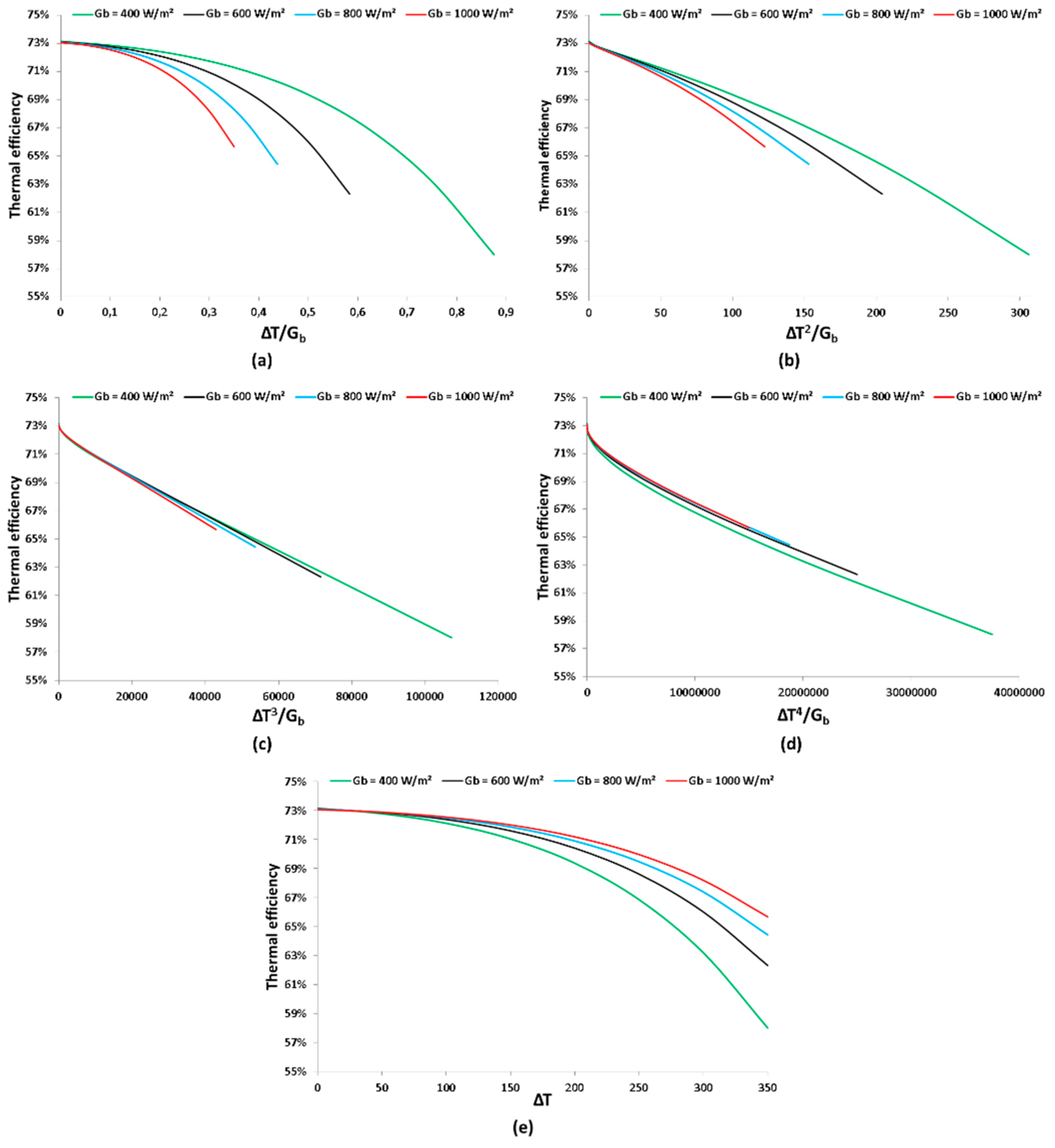
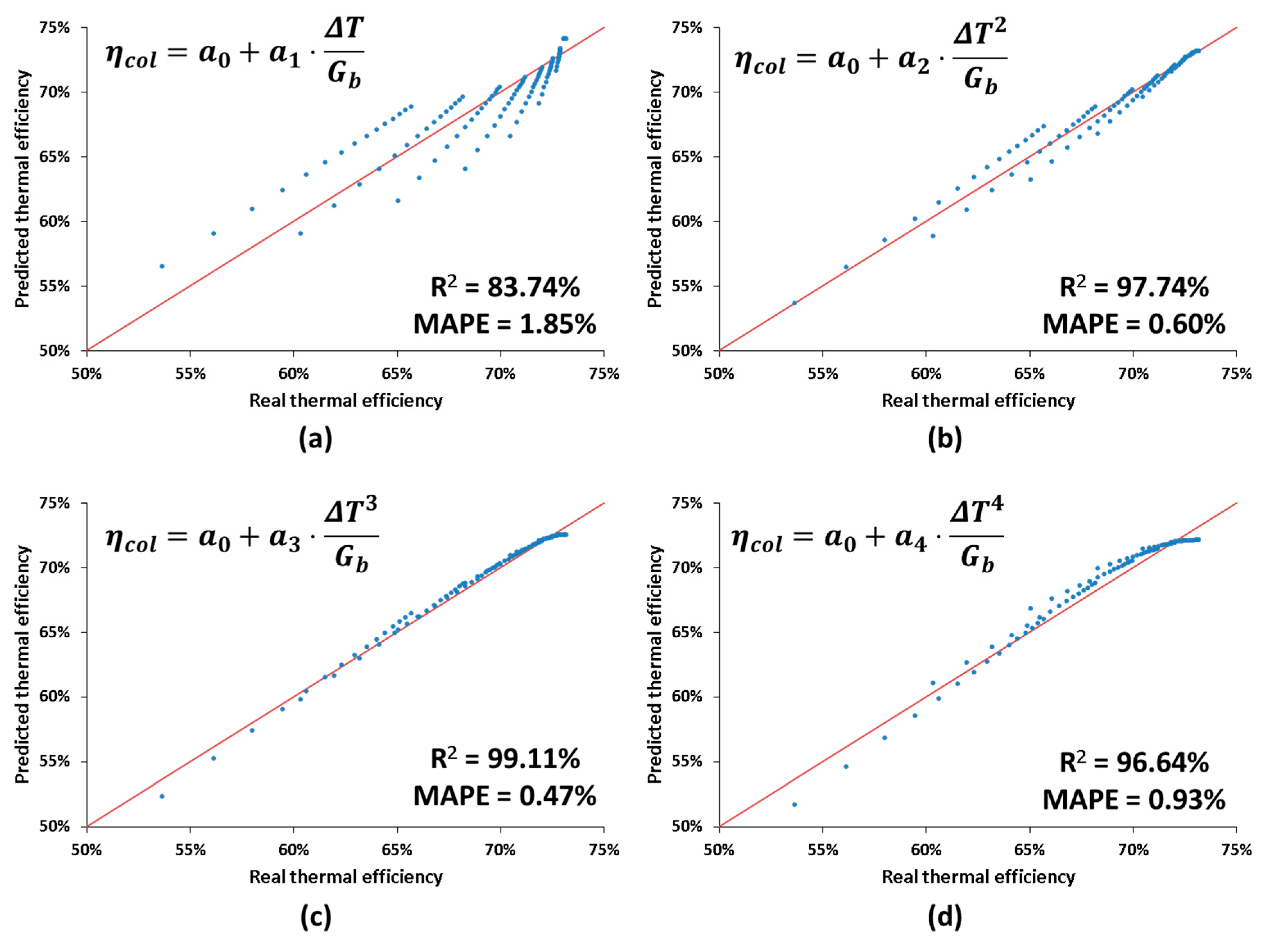
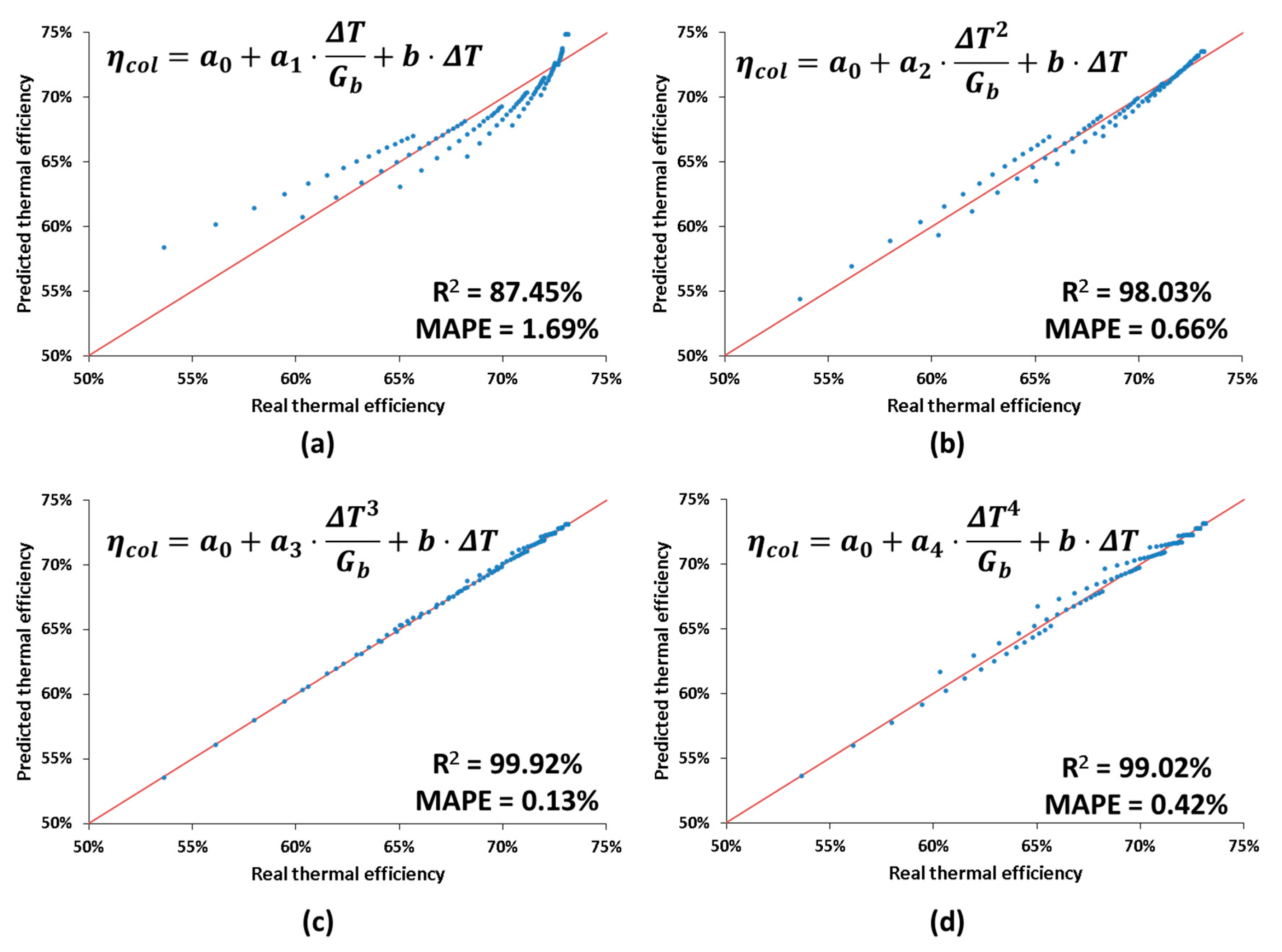
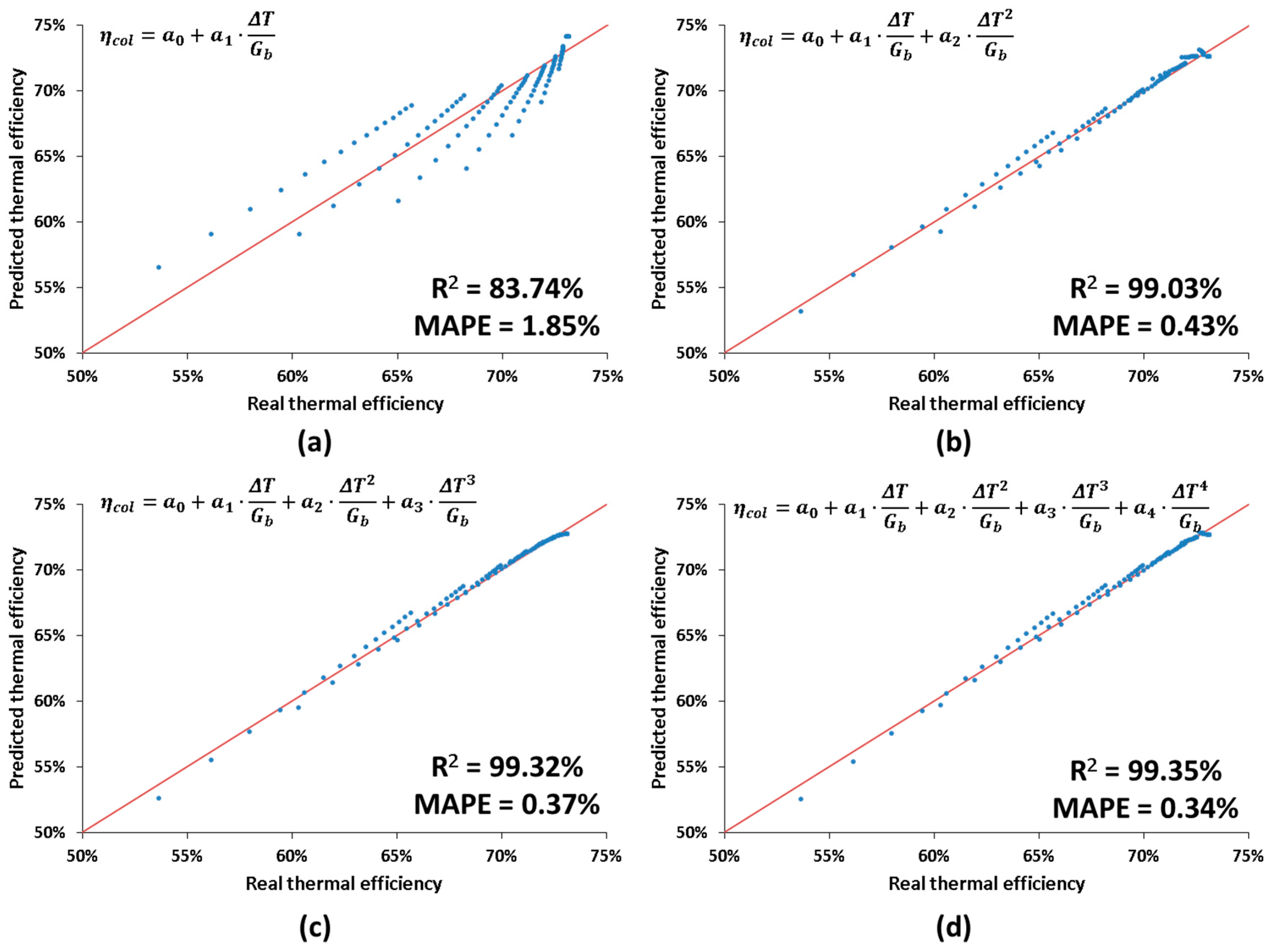

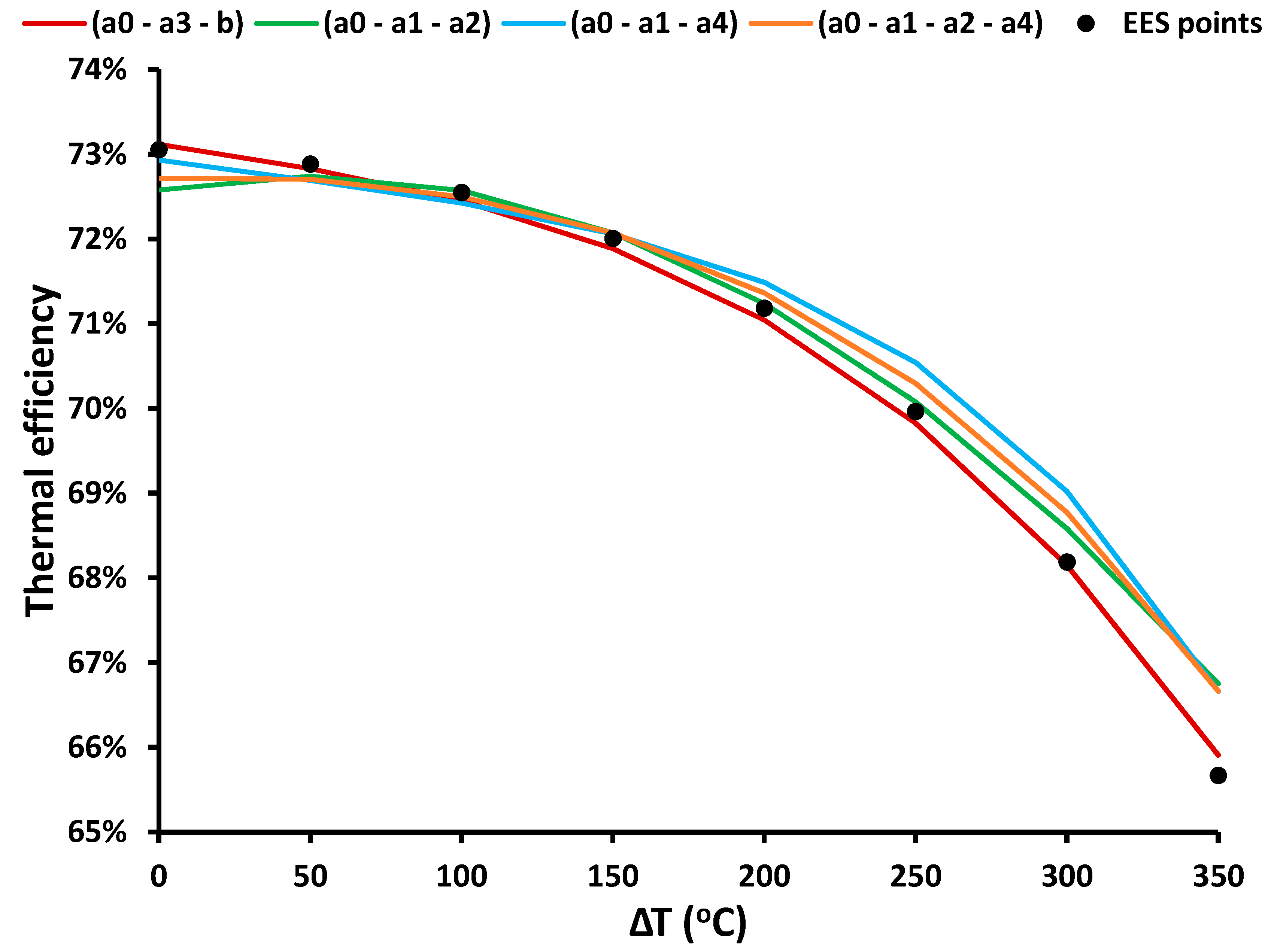
| Parameters | Symbols | Values |
|---|---|---|
| PTC width | (Wa) | 5.0 m |
| PTC length | (L) | 7.8 m |
| Focal distance | (F) | 1.84 m |
| Collecting area | (Aa) | 39 m2 |
| Concentration ratio | (C) | 22.7 |
| Inner diameter of the receiver | (Dri) | 66 mm |
| Outer diameter of the receiver | (Dro) | 70 mm |
| Inner diameter of the cover | (Dci) | 109 mm |
| Outer diameter of the cover | (Dco) | 115 mm |
| Cover emittance | (εc) | 86% |
| Solar angle | (θ) | 0° |
| Ambient temperature | (Tam) | 25 °C |
| Volumetric flow rate | (V) | 100 L/min |
| Wind speed | (Vw) | 1 m/s |
| Maximum optical efficiency | (ηopt,max) | 75.3% |
| Transmittance | (τ) | 95% |
| Absorbance | (α) | 96% |
| Equivalent reflectance | (ρ) | 83% |
| Intercept factor | (γ) | 99.5% |
| Cases | Gb | Vw | Tam | Tin | V | Outlet Temperature Tout (°C) | Collector Thermal Efficiency ηcol | ||||
|---|---|---|---|---|---|---|---|---|---|---|---|
| (W/m2) | (m/s) | (°C) | (°C) | (L/min) | Ref [18] | Model | Deviation | Ref [18] | Model | Deviation | |
| 1 | 933.7 | 2.6 | 21.2 | 102.2 | 47.7 | 124.0 | 124.1 | 0.58% | 0.7251 | 0.7209 | 1.38% |
| 2 | 968.2 | 3.7 | 22.4 | 151.0 | 47.8 | 173.3 | 173.6 | 0.89% | 0.7090 | 0.7153 | 2.29% |
| 3 | 982.3 | 2.5 | 24.3 | 197.5 | 49.1 | 219.5 | 219.9 | 0.88% | 0.7017 | 0.7079 | 1.83% |
| 4 | 909.5 | 3.3 | 26.3 | 250.7 | 54.7 | 269.4 | 269.4 | 0.95% | 0.7025 | 0.6958 | 0.76% |
| 5 | 937.9 | 1.0 | 26.2 | 297.8 | 55.5 | 316.4 | 317.0 | 0.01% | 0.6798 | 0.6799 | 0.85% |
| 6 | 880.6 | 2.9 | 28.8 | 299.0 | 55.6 | 317.2 | 316.9 | 1.70% | 0.6892 | 0.6775 | 2.66% |
| 7 | 903.2 | 4.2 | 27.5 | 355.9 | 56.3 | 374.0 | 374.3 | 3.88% | 0.6234 | 0.6476 | 1.18% |
| 8 | 920.9 | 2.6 | 31.1 | 379.5 | 56.8 | 398.0 | 398.3 | 0.86% | 0.6382 | 0.6327 | 2.12% |
| Mean | - | - | - | - | - | - | - | 1.22% | - | - | 1.68% |
| Terms | a0 | a1 | a2 | a3 | a4 | b | R2 (%) | MAPE |
|---|---|---|---|---|---|---|---|---|
| 2 terms | 0.74137 | −1.5091∙10−1 | 83.74 | 1.85% | ||||
| 0.73177 | −4.7848∙10−4 | 97.74 | 0.60% | |||||
| 0.72547 | −1.4155∙10−6 | 99.11 | 0.47% | |||||
| 0.72123 | −4.0835∙10−9 | 96.64 | 0.93% | |||||
| 0.74828 | −3.0396∙10−4 | 73.60 | 2.27% | |||||
| 3 terms | 0.72579 | 6.5758∙10−2 | −6.6344∙10−4 | 99.03 | 0.43% | |||
| 0.72773 | −1.6142∙10−2 | −1.2901∙10−6 | 99.29 | 0.38% | ||||
| 0.72930 | −4.7559∙10−2 | −3.0666∙10−9 | 98.96 | 0.48% | ||||
| 0.74828 | −1.0610∙10−1 | −1.1801∙10−4 | 87.45 | 1.69% | ||||
| 0.72733 | −1.2798∙10−4 | −1.0450∙10−6 | 99.32 | 0.37% | ||||
| 0.72786 | −2.7576∙10−4 | −1.8163∙10−9 | 99.31 | 0.36% | ||||
| 0.73484 | −4.3829∙10−4 | −3.5114∙10−5 | 98.03 | 0.66% | ||||
| 0.72672 | −1.8891∙10−6 | 1.3942∙10−9 | 99.28 | 0.39% | ||||
| 0.73116 | −1.2402∙10−6 | −5.4012∙10−5 | 99.92 | 0.13% | ||||
| 0.73131 | −3.3020∙10−9 | −8.6225∙10−5 | 99.02 | 0.42% | ||||
| 4 terms | 0.72722 | 3.1334∙10−3 | −1.5039∙10−4 | −1.0045∙10−6 | 99.32 | 0.37% | ||
| 0.72715 | 1.5569∙10−2 | −3.5634∙10−4 | −1.4867∙10−9 | 99.33 | 0.35% | |||
| 0.72912 | 6.8755∙10−2 | −6.2450∙10−4 | −4.1393∙10−5 | 99.44 | 0.37% | |||
| 0.72747 | −1.0444∙10−2 | −1.5393∙10−6 | 6.0320∙10−10 | 99.30 | 0.38% | |||
| 0.73159 | −5.1150∙10−3 | −1.2095∙10−6 | −5.1237∙10−5 | 99.93 | 0.12% | |||
| 0.73355 | −3.1857∙10−2 | −2.8667∙10−9 | −5.9099∙10−5 | 99.83 | 0.21% | |||
| 0.72758 | −1.9966∙10−4 | −5.3268∙10−7 | −8.9736∙10−10 | 99.32 | 0.36% | |||
| 0.73132 | −2.9081∙10−5 | −1.1642∙10−6 | −5.1489∙10−5 | 99.92 | 0.13% | |||
| 0.73195 | −1.9125∙10−4 | −2.0366∙10−9 | −5.2354∙10−5 | 99.94 | 0.11% | |||
| 0.73118 | −1.3011∙10−6 | 1.6766∙10−10 | −5.2787∙10−5 | 99.92 | 0.13% | |||
| 5 terms | 0.72692 | 4.2360∙10−2 | −7.6078∙10−4 | 1.8604∙10−6 | −4.1291∙10−9 | 99.35 | 0.34% | |
| 0.73204 | −1.6581∙10−2 | 9.2495∙10−5 | −1.3823∙10−6 | −5.3043∙10−5 | 99.94 | 0.12% | ||
| 0.73180 | 2.8579∙10−3 | −2.0646∙10−4 | −1.9750∙10−9 | −5.2093∙10−5 | 99.94 | 0.11% | ||
| 0.73201 | −1.1240∙10−2 | −9.2301∙10−7 | −6.8699∙10−10 | −5.2933∙10−5 | 99.94 | 0.11% | ||
| 0.73182 | −1.5901∙10−4 | −2.2711∙10−7 | −1.6443∙10−9 | −5.2227∙10−5 | 99.94 | 0.11% | ||
| 6 terms | 0.731871 | −2.5171∙10−3 | −1.2555∙10−4 | −3.6843∙10−7 | −1.4544∙10−9 | −5.2378∙10−5 | 99.94 | 0.11% |
© 2020 by the authors. Licensee MDPI, Basel, Switzerland. This article is an open access article distributed under the terms and conditions of the Creative Commons Attribution (CC BY) license (http://creativecommons.org/licenses/by/4.0/).
Share and Cite
Bellos, E.; Tzivanidis, C. Polynomial Expressions for the Thermal Efficiency of the Parabolic Trough Solar Collector. Appl. Sci. 2020, 10, 6901. https://doi.org/10.3390/app10196901
Bellos E, Tzivanidis C. Polynomial Expressions for the Thermal Efficiency of the Parabolic Trough Solar Collector. Applied Sciences. 2020; 10(19):6901. https://doi.org/10.3390/app10196901
Chicago/Turabian StyleBellos, Evangelos, and Christos Tzivanidis. 2020. "Polynomial Expressions for the Thermal Efficiency of the Parabolic Trough Solar Collector" Applied Sciences 10, no. 19: 6901. https://doi.org/10.3390/app10196901
APA StyleBellos, E., & Tzivanidis, C. (2020). Polynomial Expressions for the Thermal Efficiency of the Parabolic Trough Solar Collector. Applied Sciences, 10(19), 6901. https://doi.org/10.3390/app10196901






